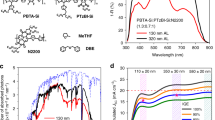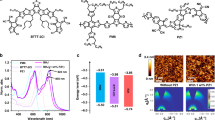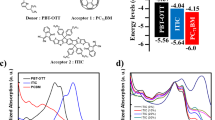Abstract
Broadening the absorption bandwidth of polymer solar cells by incorporating multiple absorber donors into the bulk-heterojunction active layer is an attractive means of resolving the narrow absorption of organic semiconductors. However, this leads to a much more complicated system, and previous efforts have met with only limited success. Here, several dual-donor and multi-donor bulk-heterojunction polymer solar cells based on a pool of materials with different absorption ranges and preferred molecular structures were studied. The study shows clearly that compatible polymer donors can coexist harmoniously, but the mixing of incompatible polymers can lead to severe molecular disorder and limit device performance. These results provide guidance for the general use of multiple-donor bulk heterojunctions to overcome the absorption limitation and achieve both high performance and fabrication simplicity for organic solar cells.
This is a preview of subscription content, access via your institution
Access options
Subscribe to this journal
Receive 12 print issues and online access
$209.00 per year
only $17.42 per issue
Buy this article
- Purchase on Springer Link
- Instant access to full article PDF
Prices may be subject to local taxes which are calculated during checkout





Similar content being viewed by others
References
Li, G., Zhu, R. & Yang, Y. Polymer solar cells. Nature Photon. 6, 153–161 (2012).
Gunes, S., Neugebauer, H. & Sariciftci, N. S. Conjugated polymer-based organic solar cells. Chem. Rev. 107, 1324–1338 (2007).
Peumans, P., Yakimov, A. & Forrest, S. R. Small molecular weight organic thin-film photodetectors and solar cells. J. Appl. Phys. 93, 3693–3723 (2003).
Halls, J. J. M. et al. Efficient photodiodes from interpenetrating polymer networks. Nature 376, 498–500 (1995).
Shaheen, S. E. et al. 2.5% efficient organic plastic solar cells. Appl. Phys. Lett. 78, 841 (2001).
Brabec, J., Sariciftci, N. S. & Hummelen, J. C. Plastic solar cells. Adv. Funct.Mater. 11, 15–26 (2001).
Clarke, T. M. & Durrant, J. R. Charge photogeneration in organic solar cells. Chem. Rev. 110, 6736–6767 (2010).
Kniepert, J., Schubert, M., Blakesley, J. C. & Neher, D. Photogeneration and recombination in P3HT/PCBM solar cells probed by time-delayed collection field experiments. J. Phys. Chem. C 2, 700–705 (2011).
Li, G. et al. High-efficiency solution processable polymer photovoltaic cells by self-organization of polymer blends. Nature Mater. 4, 864–868 (2005).
Liang, Y. et al. For the bright future—bulk heterojunction polymer solar cells with power conversion efficiency of 7.4%. Adv. Mater. 22, 135–138 (2010).
Dou, L. et al. Tandem polymer solar cells featuring a spectrally matched low-bandgap polymer. Nature Photon. 6, 180–185 (2012).
Chen, H. et al. Polymer solar cells with enhanced open-circuit voltage and efficiency. Nature Photon. 3, 649–653 (2009).
Small, C. E. et al. High-efficiency inverted dithienogermole-thienopyrrolodione-based polymer solar cells. Nature Photon. 6, 115–120 (2011).
He, Z. et al. Enhanced power-conversion efficiency in polymer solar cells using an inverted device structure. Nature Photon. 6, 593–597 (2012).
You, J. et al. A polymer tandem solar cell with 10.6% power conversion efficiency. Nature Commun. 4, 1446 (2013).
Green, M. A. et al. Solar cell efficiency tables (version 39). Prog. Photovolt. Res. Appl. 20, 12–20 (2012).
Li, G. et al. Solvent annealing effect in polymer solar cells based on poly(3-hexylthiophene) and methanofullerenes. Adv. Funct. Mater. 17, 1636–1644 (2007).
Ameri, T., Khoram, P., Min, J. & Brabec, C. J. Organic ternary solar cells: a review. Adv. Mater. 25, 4245–4266 (2013).
Dou, L. et al. Systematic investigation of benzodithiophene- and diketopyrrolopyrrole-based low-bandgap polymers designed for single junction and tandem polymer solar cells. J. Am. Chem. Soc. 134, 10071–1007 (2012).
Liang, Y. & Yu, L. A new class of semiconducting polymers for bulk heterojunction solar cells with exceptionally high performance. Acc. Chem. Res. 43, 1227–1236 (2010).
Hou, J. et al. Synthesis of a low band gap polymer and its application in highly efficient polymer solar cells. J. Am. Chem. Soc. 131, 15586–15587 (2009).
Jankovic, V. et al. Active layer-incorporated, spectrally-tuned Au/SiO2 core/shell nanorod-based light trapping for organic photovoltaics. ACS Nano 7, 3815–3822 (2013).
Dou, L. et al. A selenium-substituted low-bandgap polymer with versatile photovoltaic applications. Adv. Mater. 25, 825–831 (2013).
Huang, Y. et al. Small- and wide-angle X-ray scattering characterization of bulk heterojunction polymer solar cells with different fullerene derivatives. J. Phys. Chem. C 116, 10238–10244 (2012).
Liang, Y. Y. et al. Development of new semiconducting polymers for high performance solar cells. J. Am. Chem. Soc. 131, 56–57 (2009).
Liang, Y. Y. et al. Highly efficient solar cell polymers developed via fine tuning of structural and electronic properties. J. Am. Chem. Soc. 131, 7792–7799 (2009).
Piliego, C. et al. Synthetic control of structural order in N-alkylthieno[3,4-c]pyrrole-4,6-dione-based polymers for efficient solar cells. J. Am. Chem. Soc. 132, 7595–7597 (2010).
Bartelt, J. A. et al. The importance of fullerene percolation in the mixed regions of polymer–fullerene bulk heterojunction solar cells. Adv. Energy Mater. 3, 364–374 (2013).
Rivnay, J. et al. Drastic control of texture in a high performance n-type polymeric semiconductor and implications for charge transport. Macromolecules 44, 5246–5255 (2011).
Pivrikas, A., Sariciftci, N. S., Juška, G. & Österbacka, R. A review of charge transport and recombination in polymer/fullerene organic solar cells. Prog. Photovolt. Res. Appl. 15, 677–696 (2007).
Mozer, A. J. et al. Charge transport and recombination in bulk heterojunction solar cells studied by the photoinduced charge extraction in linearly increasing voltage technique. Appl. Phys. Lett. 86, 112104 (2005).
Khlyabich, P. P., Burkhart, B. & Thompson, B. C. Efficient ternary blend bulk heterojunction solar cells with tunable open-circuit voltage. J. Am. Chem. Soc. 133, 14534–14537 (2011).
Khlyabich, P. P., Burkhart, B. & Thompson, B. C. Compositional dependence of the open-circuit voltage in ternary blend bulk heterojunction solar cells based on two donor polymers. J. Am. Chem. Soc. 134, 9074–9077 (2012).
Maurano, A. et al. Recombination dynamics as a key determinant of open circuit voltage in organic bulk heterojunction solar cells: a comparison of four different donor polymers. Adv. Mater. 22, 4987–4992 (2010).
Vandewal, K., Tvingstedt, K., Gadisa, A., Inganäs, O. & Manca, J. V. On the origin of the open-circuit voltage of polymer–fullerene solar cells. Nature Mater. 8, 904–909 (2009).
Street, R. A., Davies, D., Khlyabich, P. P., Burkhart, B. & Thompson, B. C. Origin of the tunable open-circuit voltage in ternary blend bulk heterojunction organic solar cells. J. Am. Chem. Soc. 135, 986–989 (2013).
Shuttle, C. G. et al. Experimental determination of the rate law for charge carrier decay in a polythiophene fullerene solar cell. Appl. Phys. Lett. 92, 093311 (2008).
Shuttle, C. G. et al. Charge extraction analysis of charge carrier densities in a polythiophene/fullerene solar cell: analysis of the origin of the device dark current. Appl. Phys. Lett. 93, 183501 (2008).
Shuttle, C. G., Hamilton, R., O'Regan, B. C. Nelson, J. A. & Durrant, J. R. Charge-density-based analysis of the current–voltage response of polythiophene/fullerene photovoltaic devices. Proc. Natl Acad. Sci. USA 107, 16448–16452 (2010).
Chen, W. et al. Hierarchical nanomorphologies promote exciton dissociation in polymer/fullerene bulk heterojunction solar cells. Nano Lett. 11, 3707–3713 (2011).
Rivnay, J., Noriega, R., Kline, R. J., Salleo, A. & Toney, M. F. Quantitative analysis of lattice disorder and crystallite size in organic semiconductor thin films. Phys Rev. B 84, 045203 (2011).
Chen, W., Nikiforov, M. P., Darling, S. B. Morphology characterization in organic and hybrid solar cells. Energy Environ. Sci. 5, 8045–8074 (2012).
Löslein, H. et al. Transient absorption spectroscopy studies on polythiophene–fullerene bulk heterojunction organic blend films sensitized with a low-bandgap polymer. Macromol. Rapid. 34, 1090–1097 (2013).
Brunner-Popela, J. & Glatter, O. Small-angle scattering of interacting particles. I. Basic principles of a global evaluation technique. J. Appl. Crystallogr. 30, 431–442 (1997).
Weyerich, B., Brunner-Popela, J. & Glatter, O. Small-angle scattering of interacting particles. II. Generalized indirect Fourier transformation under consideration of the effective structure factor for polydisperse systems. J. Appl. Crystallogr. 32, 197–209 (1999).
Acknowledgements
The authors acknowledge financial support from the Office of Naval Research (Program manager P. Armistead, award nos. N00014-11-1-0250 and N00014-14-1-0648). The authors thank W.L. Kwan, Z. Hong, J. You, R. Zhu, B. Street and S.A. Hawks for technical discussions. W.C. acknowledges financial support from the US Department of Energy, Office of Science, Office of Basic Energy Sciences (award no. KC020301). The authors also thank J. Strzalka and C. Wang for assistance with GISAXS and RSoXS measurements. Use of the Advanced Photon Source (APS) at Argonne National Laboratory was supported by the US Department of Energy, Office of Science, Office of Basic Energy Sciences (contract no. DE-AC02-06CH11357). The ALS at Lawrence Berkeley National Laboratory is supported by the Director, Office of Science, Office of Basic Energy Sciences, of the US Department of Energy (contract no. DE-AC02-05CH11231).
Author information
Authors and Affiliations
Contributions
Y.(M.)Y., G.L. and Y.Y. conceived and developed the ideas. Y.(M.)Y. designed the experiments and performed device fabrication, electrical characterization (CELIV, TPV and highly sensitive PSR) and data analysis. W.C. performed GIWAXS and RSoXS measurements and analysed the data. L.D. and W.-H.C. synthesized and provided the low-bandgap polymers of PBDTT-DPP and PBDTT-SeDPP. S.D. assisted with highly sensitive PSR measurements. Y.(M.)Y., G.L. and Y.Y. wrote the manuscript. B.B. and W.C. contributed to revision of the manuscript. The projects were supervised by Y.Y. and G.L.
Corresponding authors
Ethics declarations
Competing interests
The authors declare no competing financial interests.
Supplementary information
Supplementary information
Supplementary information (PDF 3252 kb)
Rights and permissions
About this article
Cite this article
Yang, Y., Chen, W., Dou, L. et al. High-performance multiple-donor bulk heterojunction solar cells. Nature Photon 9, 190–198 (2015). https://doi.org/10.1038/nphoton.2015.9
Received:
Accepted:
Published:
Issue Date:
DOI: https://doi.org/10.1038/nphoton.2015.9
This article is cited by
-
Rational molecular and device design enables organic solar cells approaching 20% efficiency
Nature Communications (2024)
-
A materials physics perspective on structure–processing–function relations in blends of organic semiconductors
Nature Reviews Materials (2023)
-
Models and mechanisms of ternary organic solar cells
Nature Reviews Materials (2023)
-
An Organic Small Molecule as a Solid Additive in Non-Fullerene Organic Solar Cells with Improved Efficiency and Operational Stability
Chinese Journal of Polymer Science (2023)
-
Recent progress in organic waste recycling materials for solar cell applications
Environmental Science and Pollution Research (2023)



